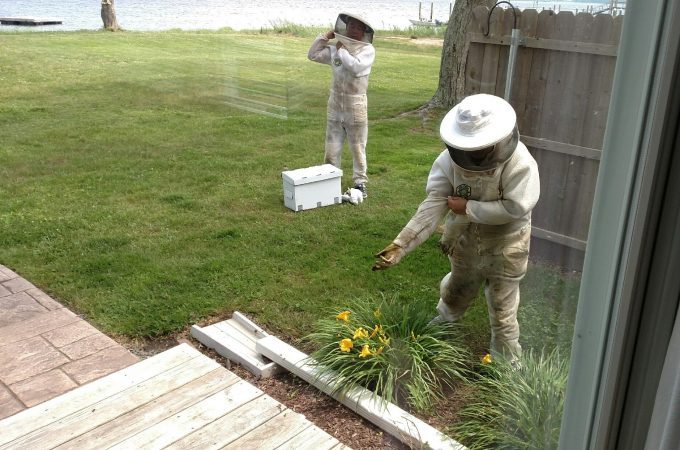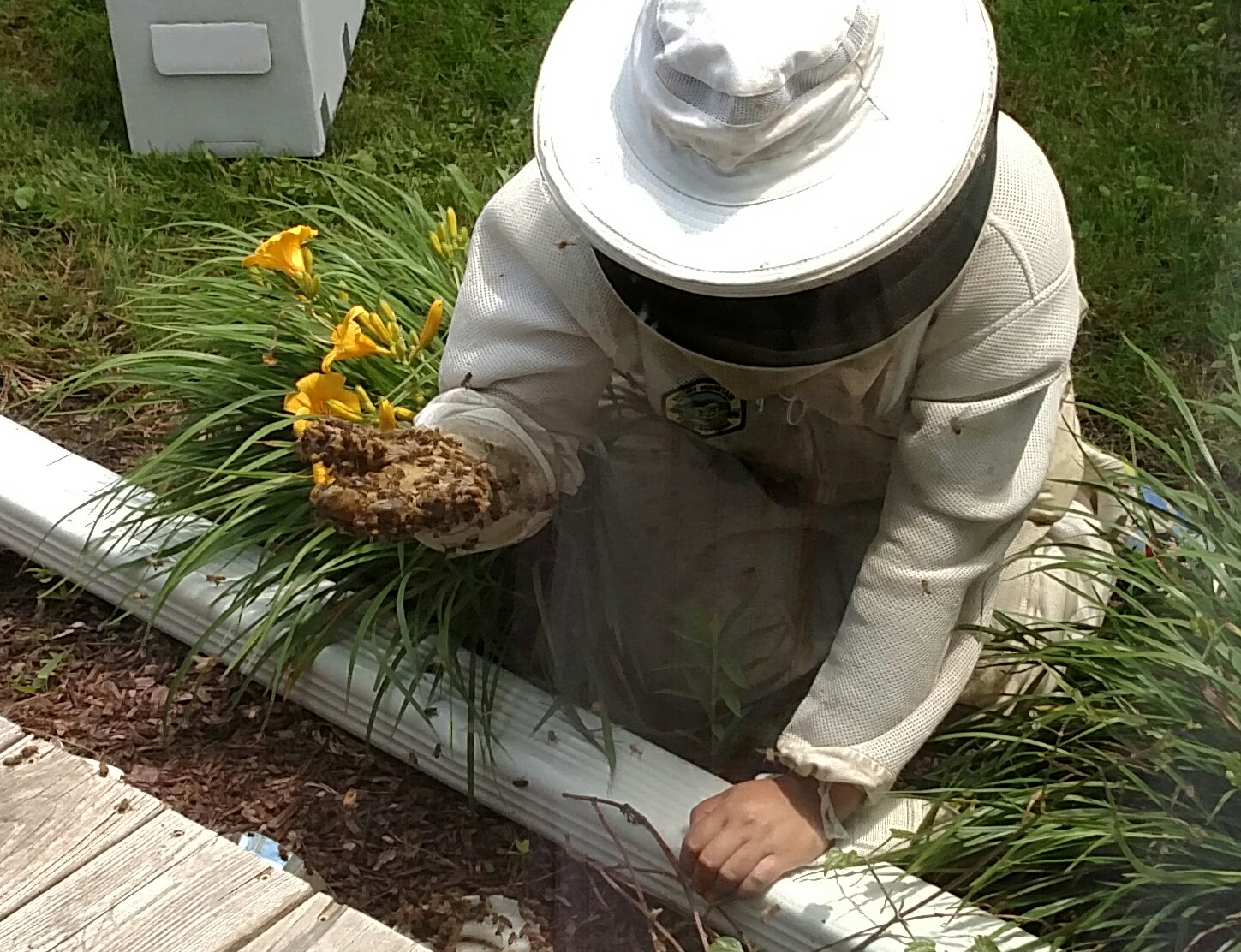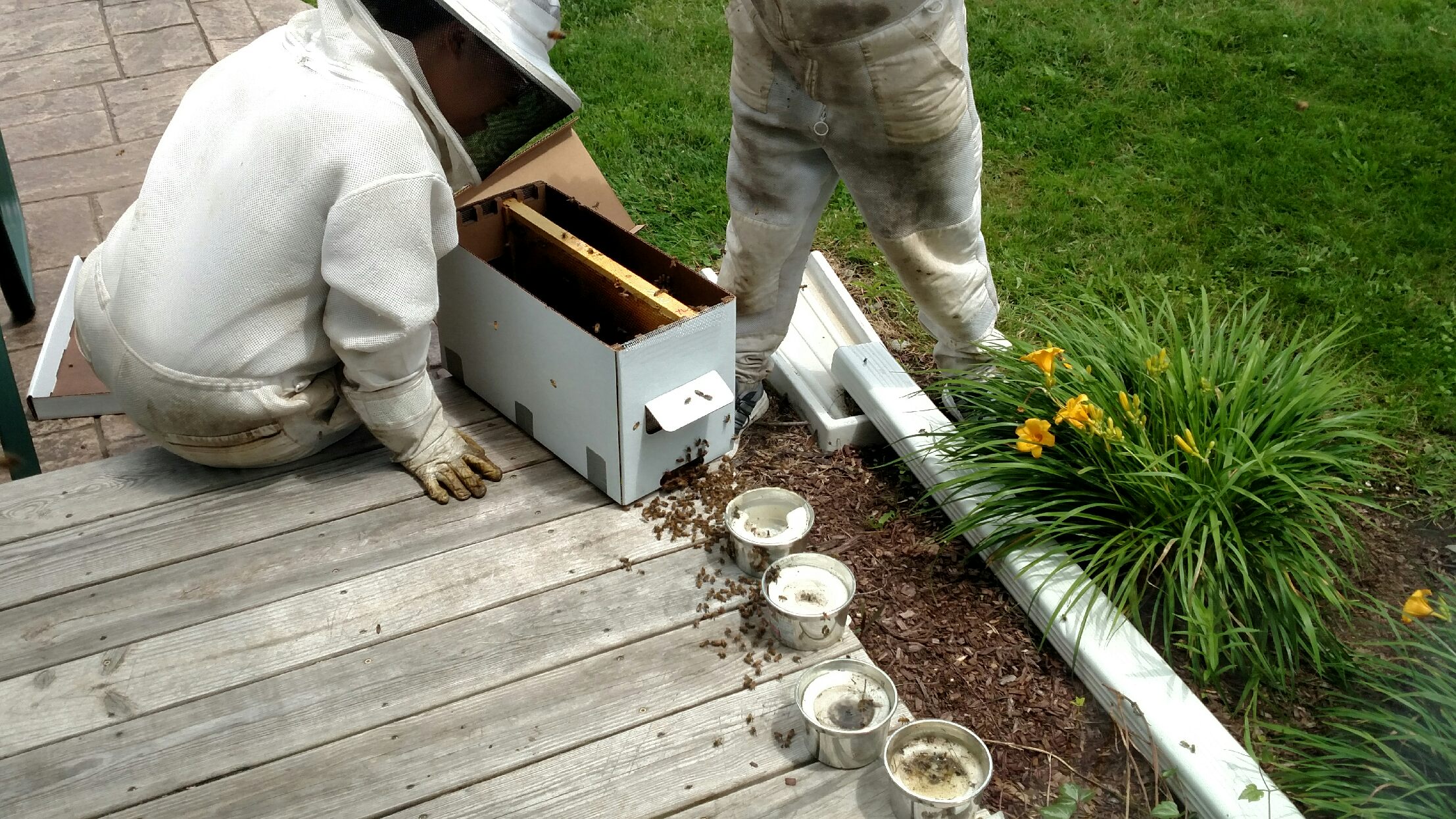A Honey Bee story
Like an army getting its marching orders, the bees rapidly filed into the box

I have a honey bee story.
A few weeks ago, a swarm of honey bees appeared one morning on the edge of our deck. Like out of nowhere. No prior activity.
We were told that it’s illegal to kill honey bees, so our only option was to call a beekeeper to relocate the swarm. Even if it were legal to kill them, we would not have done that since honey bees play an important role in nature and are under enormous stress from a virus causing bee colony collapse.
In one of those “what’s the chance” happenings, a couple down the street from us are hobbyist beekeepers. They maintain their hives at local community farms. They also raise Queens.
We called them, and they rushed to our house because they really, really wanted the colony.

When they arrived, they diagnosed the problem. We had citronella candles just under the deck that had accumulated water, drawing out the lemon grass extract. That scent mimics the scent of a Queen bee. So the swarm arrived expecting to find a Queen, but there was none.
The beekeepers said that after a while the swarm would realize there was no Queen and leave, but it could take a couple of days.
They brought over a cardboard bee box, and put a scent in there that also mimics a Queen. Like an army getting its marching order, the bees rapidly filed into the box. Problem solved.

The beekeepers said they would give the colony a Queen and relocate them to a farm.
This is a long-winded way of presenting a “relatively” good-news story about honey bee survival (h/t Cameron Gray on Twitter). From Bloomberg via the San Francisco Chronicle, Good news for bees as numbers rise and mystery malady wanes:
The number of U.S. honeybees, a critical component to agricultural production, rose in 2017 from a year earlier, and deaths of the insects attributed to a mysterious malady that’s affected hives in North America and Europe declined, according a U.S. Department of Agriculture honeybee health survey released Tuesday.
The number of commercial U.S. honeybee colonies rose 3 percent to 2.89 million as of April 1, 2017 compared with a year earlier, the Agriculture Department reported. The number of hives lost to Colony Collapse Disorder, a phenomenon of disappearing bees that has raised concerns among farmers and scientists for a decade, was 84,430 in this year’s first quarter, down 27 percent from a year earlier. Year-over-year losses declined by the same percentage in April through June, the most recent data in the survey.
Still, more than two-fifths of beekeepers said mites were harming their hives, and with pesticides and other factors still stressing bees, the overall increase is largely the result of constant replenishment of losses, the study showed.
In my discussions with the neighbors, I learned how complicated the hive is. Really fascinating stuff.
It’s *almost* like they are a higher form of intelligence, as this recent article discusses, Technology tracks ‘bee talk’ to help improve honey bee health:
Simon Fraser University graduate student Oldooz Pooyanfar is monitoring what more than 20,000 honeybees housed in hives in a Cloverdale field are “saying” to each other—looking for clues about their health.
Pooyanfar’s technology is gleaning communication details from sound within the hives with her beehive monitoring system—technology she developed at SFU. She says improving knowledge about honey bee activity is critical, given a 30 per cent decline in the honeybee population over the past decade in North America….
“To learn about what bees are communicating, we can either look at pheromones—the chemical they produce—or sound,” says Pooyanfar ….
I also learned from my neighbors that Cornell has world-renowned researchers on bees at our agricultural school. Who knew?
So all ended well.
The honey bees found a new home. The beekeepers gained a new colony. I didn’t get stung. And I learned a lot.
Donations tax deductible
to the full extent allowed by law.








Comments
TY for the early Sunday morning smile.
The colony probably escaped from your neighbors hives. The bee colony collapse story was hyped. and native bees like the miner bee and its cousins pollinate 250x more than a honey bee. Also they are active at 45 degrees F.
So know all your bees.
Honeybees are backbone of agriculture. But they escape to become an invasive species. Taking over tree hollows nesting areas they replaced indigenous birds.
Honeybees killed the Carolina parakeet and the Ivory Billed Woodpecker.
no the ivory billed woodpecker went extinct because its habitat was destroyed as well as the insect larva that it fed on.
https://www.allaboutbirds.org/guide/Ivory-billed_Woodpecker/lifehistory
http://www.birds.cornell.edu/ivory/aboutibwo/slide_extinction_html
https://www.allaboutbirds.org/carolina-parakeet-removal-of-a-menace/
https://www.nationalgeographic.org/thisday/feb21/carolina-parakeets-go-extinct/
That could be true. However I just finished reading the latest monograph on the subject – The Search for the Ivory Billed Woodpecker. The latest literature suggests that because the Woodpecker and the Carolina Parakeet both nested in the hollows of trees – they were unable to nest when the bees took over.
The reasoning behind this was the fact that the numbers of both birds plummeted by 90% prior to the major habitat destruction. There are still plenty of uninhabited swamps and places like Big Thicket in Texas and the Okefenokee Swamp in Florida where both birds should have continued to thrive.
Of course, when the bird numbers dropped, people started hunting the birds for their novelty.
Probably no single factor killed the birds.
So the swarm arrived expecting to find a Queen, but there was none.
Huh, that’s a pretty good description of the Dimocrats, in the last presidential election.
Colony collapse disorder is real but not really well understood. Beepocalypse however is not real but is really well understood – creating a panic so government can increase its regulations, funding and power is as old a human disorder as government itself.
Capitalism hasn’t solved colony collapse disorder yet but it has made sure there is no commercial impact:
http://reason.com/archives/2017/07/19/how-capitalism-saved-the-bees/
The bee “crisis” is a perennial story that is managed by reporting it hysterically whenever bee numbers are down and ignoring it whenever they’re up. The same is true of the “frog crisis” and the “monarch butterfly crisis”; whenever frogs or butterflies are mysteriously dying of whatever it is that periodically kills them off, we hear all about it, but when their numbers shoot up again it’s not news, so we never hear about them until the next die-off, at which time all the news stories about the last die-off are revived, and we remember all that coverage, so we’re misled to believe that the crisis has been going on all along.
A reader sent me this story. Glad I didn’t try it. Georgia homeowner tries to burn bees nest, sets home ablaze
Video feed inside a honeybee hive. Claustrophobic bees have a hard life.
http://explore.org/live-cams/player/honey-bee-hive-cam
The trolls on this blog sound exactly like these bees as they rush into the cardboard box.
Is there a farm we can relocate them to as well?
If you are surprised by the hidden intelligence of bees, you’ll be equally fascinated by the apparent intelligence of plants:
https://www.pri.org/stories/2014-01-09/new-research-plant-intelligence-may-forever-change-how-you-think-about-plants
https://www.ted.com/talks/stefano_mancuso_the_roots_of_plant_intelligence
The summary of all this is that bees, our trolls and plants have more intelligence than the GOPe.
(Is there room in that cardboard box for McCain and Flake?)
Is it really illegal to kill honeybees, or is that a state by state thing? Googling says no, but seeing as this is a law blog I figured maybe you know something the web doesn’t?
Few years back visiting some family friends a few bees were in their kitchen. Man of the house took a fly swatter to them and discovered the plaster had been undermined by an entire hive that had moved in. Fortunately actual doors on entrance ways so we didn’t have to evacuate entire house. Quick trip to store to get bug spray and several hours later the insects lost the war – did they face jailtime? Seems a bit silly….